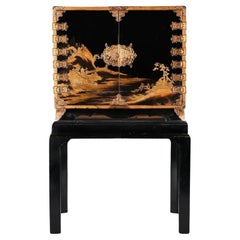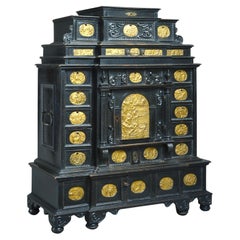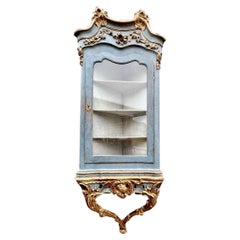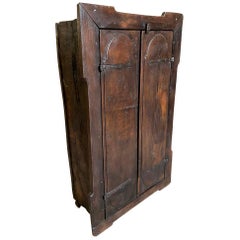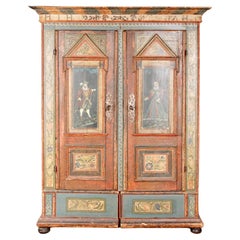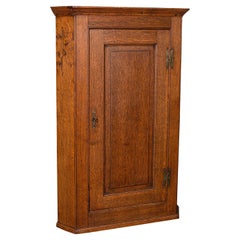18th Century and Earlier Cabinets
to
111
Height
to
Width
to
Depth
to
500
462
983
181
77
46
43
41
13
10
6
5
2
2
1
1
1
983
2,990
5,585
3,524
1,272
2,842
913
213
46
220
308
278
602
697
468
152
59
930
269
228
212
116
855
215
158
140
105
983
983
983
2
2
1
1
1
Period: 18th Century and Earlier
An Important Late 17th Century Japanese Lacquered Cabinet Edo Period on Stand
Located in Benington, Herts
An extremely fine, elegant and rare late 17th Century Japanese lacquer cabinet, from the Eco period, on later lacquered black stand.
Japanese circa 1690
Provenance
A private Scottish collection
This outstanding cabinet is a fascinating fusion of east and west. The cabinet itself would have been made in Japan, c.1690, and is decorated to the outside with hiramaki-e lacquer. This technique involves the use of sprinkled gold powder which adheres to the lacquer surface. On the best pieces, as with this example, many layers are added in order to create areas of high relief and give depth to the surface decoration. The taste of the Japanese workshops in this period was often for quite restrained pieces with plenty of the black background visible, unlike some of the busier Chinese lacquer or European japanned examples produced around the same time. The Japanese makers seemed content to rely on the outstanding quality of the lacquer itself, regarded by most experts as the finest lacquer ever produced, and did not see the need to cover every surface believing that less was more in this respect. The lacquer here is used to produce a mountainous scene with buildings on the bank of a river, the other side of the river with more buildings and a contrasting flatter and forested landscape. The fine perspective achieved is the result of the clever use of raised and flatter areas in the lacquer itself in combination with the drawing of the design itself.
Another remarkable aspect of this piece is the fine metalware throughout, but particularly the lockplate / hasp, hinges and foot mounts to the front. This is all beautifully cast and engraved contrasting against the black background. Interestingly another cabinet on stand with near identical metalwork was advertised in the Burlington Magazine, November 1913, with the dealer W. Williamson and Sons of Guildford. The lacquer on that piece is similarly refined and it seems likely that both pieces came from the same workshop.
The European influence in our piece can be seen in both the later ebonised stand and in the japanned decoration which has been applied to the inside of the doors and is also very fine indeed. This consists of two panels with birds of prey perched on branches in colours set against a golden background. The cabinet has a recent Scottish provenance and so it is likely that the ebonised stand was made in Britain though such pieces were made throughout Europe as a way of quite literally elevating these imported pieces of eastern lacquer as in Japan these would have been used on the floor. Inside the cabinet there is a combination of more Japanese lacquer and lock plates and European drawer handles. Most of the lacquer drawer fronts incorporate mountainous scenes and birds in combination, with a few purely one or the other of the two subjects. Again the lacquer is in excellent condition and is of exceptional quality with multiple layers of relief used in one single scene in many cases.
As mentioned above, Japanese lacquer is the most technically brilliant of the eastern lacquers and, as such, was highly prized by collectors and connoisseurs throughout Europe when this piece was made. The acquisition of such pieces would only have been possible for a small group of incredibly wealthy individuals, largely royal or high ranking courtiers or merchants connected with the East India trade...
Category
Japanese Edo Antique 18th Century and Earlier Cabinets
Materials
Lacquer
Fine Early 17th Century Ebonised Table Cabinet
Located in London, GB
A FINE EARLY 17TH CENTURY EBONISED TABLE CABINET INSET WITH GILT-BRASS PLAQUES, SOUTH GERMANY, PROBABLY AUGSBURG, CIRCA 1630.
The plaques depicting scenes from Ovid’s Metamorphoses.
Category
Antique 18th Century and Earlier Cabinets
Materials
Brass
18th Century Swedish Rococo Corner Vitrine
Located in Kastrup, DK
Elegant Swedish Rococo corner display cabinet in two parts, showcasing exquisite craftsmanship and refined details.
Crafted from pine wood and painted in a soft rococo blue.
Beautifu...
Category
Swedish Rococo Antique 18th Century and Earlier Cabinets
Materials
Pine
Spanish 17th Century Rustic Armoire
Located in Round Top, TX
A very handsome 17th century folk armoire from the Catalan region of Spain. Soundly constructed from thick planks of chestnut. Stunning patina - very luminous. A fabulous storage pie...
Category
Spanish Antique 18th Century and Earlier Cabinets
Materials
Chestnut
Swiss alp painted marriage cupboard dated 1779
Located in grand Lancy, CH
painted wedding cupboard dated 1779 , we see the wife and the husband on each door, the rest is richly decorated and the fittings and the lock as well as the keys are original and of...
Category
Swiss Antique 18th Century and Earlier Cabinets
Materials
Wood
Tall Antique Corner Cabinet, English, Oak, 4 Shelf Wall Cupboard, Georgian, 1800
Located in Hele, Devon, GB
This is a tall antique corner cabinet. An English, oak four shelf wall cupboard, dating to the Georgian period, circa 1800.
Superb period...
Category
British Georgian Antique 18th Century and Earlier Cabinets
Materials
Oak
18th Century Dutch Renaissance Cabinet
Located in Casteren, NL
Dutch Renaissance cabinet with two doors and one drawer.
Made from solid oakwood with mahogany veneer.
This cabinet has a rare and authentic ...
Category
Dutch Antique 18th Century and Earlier Cabinets
Materials
Oak
Charlotte Perriand – Les arcs 1600 cabinet
Located in Tokyo, Tokyo
Charlotte Perriand – Les arcs 1600 cabinet , 1970s
Category
Antique 18th Century and Earlier Cabinets
Materials
Wood
17th Century, Dutch Oakwood Cabinet
Located in Casteren, NL
Impressive Dutch Renaissance "kussenkast", four-door cabinet.
Solid oakwood with veneer.
large corniche with carved heads decor. Raised panelled doors and sides with ripple mouldings...
Category
Dutch Antique 18th Century and Earlier Cabinets
Materials
Oak
$9,276 Sale Price
20% Off
Dutch Rococo 1780s Walnut Vitrine with Bombé Chest, Glass Doors, Hunting Trophy
Located in Atlanta, GA
A Dutch Rococo period walnut vitrine cabinet from the late 18th century, with hand carved hunting trophy, glass doors and bombé chest. Born in the Netherlands in the later years of t...
Category
Dutch Rococo Antique 18th Century and Earlier Cabinets
Materials
Bronze
Important Spanish Cabinet, 17th Century
Located in Madrid, ES
Important Spanish Cabinet 17th century
in blackened wood and tortoiseshell veneer.
It opens with eight drawers framing a central door, surrounded by two columns.
Richly decorated w...
Category
Spanish Baroque Antique 18th Century and Earlier Cabinets
Materials
Bronze
Exceptionally Early Swedish Primitive Cabinet, circa 1700–1730
Located in Farsta, SE
Exceptionally Early Swedish Primitive Cabinet, circa 1700–1730
This primitive Swedish cabinet truly speaks to us.
It has never been painted, and the few restorations that have been...
Category
Swedish Scandinavian Modern Antique 18th Century and Earlier Cabinets
Materials
Pine
Antique Secretaire Cabinet, English, Chest of Drawers, Bureau, Desk, Georgian
Located in Hele, Devon, GB
This is an antique secretaire cabinet. An English, mahogany chest of drawers with drop front writing desk, dating to the Georgian period, ci...
Category
British Antique 18th Century and Earlier Cabinets
Materials
Wood
18th Century Welsh Oak Dresser
Located in High Point, NC
18th century Welsh oak dresser from England. The piece has lovely rich color and wonderful graining throughout. The crown sits atop gorgeous wide bac...
Category
English Georgian Antique 18th Century and Earlier Cabinets
Materials
Oak
Italian 18th Century 2-part "Lacca Povera" Painted Enclosed Cabinet
Located in Troy, NY
Unusual and rare “Lacca Povera” Cabinet in two parts, Italian, 18th century (ca. 1730), pine / poplar
The upper part with two louvered doors opening to a shelved interior, bottom pa...
Category
Italian Rococo Antique 18th Century and Earlier Cabinets
Materials
Poplar, Pine
Cabinet Corner Swedish Stone Top Brown Sweden
Located in New York, NY
Cabinet corner Swedish stone top brown Sweden. A low corner cabinet made during the Rococo period 1750-1775 in northern Europe. Veneered in fruit wo...
Category
Swedish Rococo Antique 18th Century and Earlier Cabinets
Late 18th Century Hand Carved and Painted Gilt Wood Venetian Cabinet
Located in Miami, FL
Late 18th Century Hand Carved and Painted Gilt Wood Venetian Cabinet
An exquisite Venetian cabinet with remarkable Rococo period details.
Gilt wood and painted in a very appealing a...
Category
Italian Rococo Antique 18th Century and Earlier Cabinets
Materials
Giltwood, Wood
18th Century Italian Pair of Baroque Cassapanche Wooden Storage Benches
Located in West Palm Beach, FL
An antique pair of high quality Cassapanca Walnut benches with the original finish, decorated with typical Italian Baroque motifs. The Cassapanche were used as storage in a castle in...
Category
Italian Baroque Antique 18th Century and Earlier Cabinets
Materials
Walnut
18th Century Inlaid Bone and MOP Walnut Table Cabinet
Located in Bradenton, FL
18th Century Inlaid Bone and Mother-of-Pearl inlaid Walnut Cabinet. Beautiful cabinet features inlaid bone that creates contrast and texture while mother-of-pearl with it's iridescen...
Category
English Queen Anne Antique 18th Century and Earlier Cabinets
Materials
Walnut
18th century Italian Painted Corner Cabinet
Located in Atlanta, GA
A late 18th century Italian painted and gilt Corner Cabinet with serpentine shape and floral decoration, ca. 1780
William Word Fine Antiques: Atlanta's source for antique interior...
Category
Italian Antique 18th Century and Earlier Cabinets
Materials
Paint
17th Century French Provincial Cupboard
Located in Tetbury, Gloucestershire
A Stunning French Walnut Provincial cupboard dating from the early 17th Century in the period of Louis XIII.Consists of four carved panelled doors with two drawers and the original ironmongery making this into a truly wonderful and usable early piece of historical antique...
Category
French Louis XVI Antique 18th Century and Earlier Cabinets
Materials
Walnut
18th Century Swedish Pine Corner Cabinet
Located in Round Top, TX
The deep patina of the warm pine in this corner cabinet is a reflection of generations of use, and is crowned by a lovely "bonnet" which was a traditional Swedish style element of th...
Category
Swedish Antique 18th Century and Earlier Cabinets
Materials
Pine
A Mid Eighteenth Century Japanese Lacquer Cabinet
Located in London, GB
Using Japanese “Urushi” lacquer in a beautifully untouched and sleepy condition, on later stand, This Japanese lacquer cabinet on the stand has...
Category
Japanese Edo Antique 18th Century and Earlier Cabinets
Materials
Wood, Lacquer
17th Century Dutch Renaissance Cabinet with Arched Doors
Located in Casteren, NL
Beautiful and rare Dutch Renaissance two-door cabinet. This cabinet stems from an era in Dutch history that is called "the golden age'.
This cabinet has the typical arched panelled doors and is called a 'poortkast' or portal cabinet.
It is made in the best quality solid oak. It stands on ebonized bun feet with an ajour cut skirt. The panelled doors have a hand-carved arched top. The top corniche has beautiful hand-carved elevated panels depicting cupids holding garlands. The whole cabinet is enriched with inlaid parts of ebony...
Category
Dutch Renaissance Antique 18th Century and Earlier Cabinets
Materials
Ebony, Mahogany, Oak
$13,796 Sale Price
20% Off
A pair of Spanish-colonial Viceregal mother-of-pearl inlaid bureau-cabinets
Located in Amsterdam, NL
Viceroyalty of Peru, Lima, 18th century, circa 1720-1760
Each with a moulded giltwood cornice and on a foliate carved giltwood base, possibly later and English. The cabinets, with s...
Category
Peruvian Spanish Colonial Antique 18th Century and Earlier Cabinets
Materials
Mother-of-Pearl, Teak
18th century Swedish painted rococo vitrine
Located in London, GB
Later painted in a creamy yellowed off white the interior painted in a muted shell pink has three useful small drawers and shelving for display and storage. It sits over three long d...
Category
Swedish Rococo Antique 18th Century and Earlier Cabinets
Materials
Oak
Antique Dutch Cabinet Crafted from Walnut and Mahogany
Located in Houston, TX
Two piece antique Dutch cabinet crafted from walnut and mahogany and newly restored. This three drawer chest offers up plenty of storage while al...
Category
European Dutch Colonial Antique 18th Century and Earlier Cabinets
Materials
Mahogany, Walnut, Wood
Incredible antique oak cabinet with 4 doors from the 18th century
Located in Harderwijk, NL
This amazing and very pure cabinet dates back to the 18th century and has a truly beautiful patina. Everything about this cabinet is perfect—the size, the working locks, the forged i...
Category
Antique 18th Century and Earlier Cabinets
Materials
Oak
Antique 18th Century German Baroque Warm Brown Solid Oak Display Cabinet
Located in Casteren, NL
This German Baroque display or kitchen cabinet has a beautiful warm brown color with soft gloss and a rich patina. The cabinet consists of two pieces. ...
Category
German Baroque Antique 18th Century and Earlier Cabinets
Materials
Steel
French Antique Oak & Wrought Iron Buffet Country Style 18th Century
Located in Labrit, Landes
French antique oak and wrought iron sideboard buffet.
Two doors and two drawers.
One shelf in the cabinet.
The interior of the buffet was entirely covered in Provencal-style fabric w...
Category
French French Provincial Antique 18th Century and Earlier Cabinets
Materials
Wrought Iron
17th Century Italian Walnut Cabinet
Located in Bradenton, FL
Beautiful rare large 17th century Italian Baroque Cabinet. In two parts with cabinet doors above and below and drawers in the middle. Carved with leaf design and cherubs or angels ar...
Category
Italian Baroque Antique 18th Century and Earlier Cabinets
Materials
Wood
German Walnut Cabinet - 18th Century
Located in Brussels, Brussels
Superb 18th century German walnut cabinet
Very beautiful piece of furniture in two parts in walnut marquetry and burr walnut from the Louis XIV period/early 18 century.
The lower pa...
Category
German Baroque Antique 18th Century and Earlier Cabinets
Materials
Walnut
Very Rare and Important 16th C. French Renaissance Cabinet or Dressoir, ca. 1580
By Jacques Androuet Du Cerceau
Located in Miami Beach, FL
Walnut with verde antico marble inlay, with two wholly carved draped female allegorical figures within arched recesses, and a bas-relief on the central door. Rich and heavily carved...
Category
French Renaissance Antique 18th Century and Earlier Cabinets
Materials
Oak, Walnut
$17,600 Sale Price
37% Off
16th-Century Aragonese Walnut and Bone Marquetry Chest
Located in Madrid, ES
This exceptional 16th-century chest is a masterful example of Aragonese craftsmanship, combining rich walnut wood with intricate geometric bone marquetry inspired by Islamic artistic...
Category
Antique 18th Century and Earlier Cabinets
Materials
Fruitwood
Swedish Primitive Cabinet from Dalarna, ca 1790–1830
Located in Farsta, SE
Swedish Primitive Cabinet from Dalarna, ca 1790–1830
You take what you have - old repairs, mostly done with old horseshoes.
The patina is truly beautif...
Category
Swedish Scandinavian Modern Antique 18th Century and Earlier Cabinets
Materials
Pine
17TH Century Papillero Vargueno On Stand
Located in Lincolnshire, GB
A super example of a Spanish 17th century walnut and parcel gilt Papillero Vargueno on stand. The drawer fronts with bone inlays and columns with finely painted flowers. Central door...
Category
Spanish Antique 18th Century and Earlier Cabinets
Materials
Walnut
18th Original Italian Cabinet on Stand, Baroque Bargueno with Carey Inlays
Located in Miami, FL
Italian cabinet on table. Walnut and rosewood, hawksbill, bronze in color and gilded, 17th century.
Sample desktop pool located on ball and claw with handles on the sides. The front...
Category
Italian Baroque Antique 18th Century and Earlier Cabinets
Materials
Bronze
18th Century French Enfilade
Located in Atlanta, GA
This exceptional 18th-century French enfilade is a stunning example of Louis XV style, showcasing the elegance and craftsmanship of its time. Crafted from solid walnut, the enfilade ...
Category
French Louis XV Antique 18th Century and Earlier Cabinets
Materials
Walnut
18th Century English Mahogany Bowfront Hanging Corner Cupboard
Located in Savannah, GA
Late 18th century English mahogany bowfront hanging cupboard featuring string inlay on the doors with bone escutcheons, three curved interior drawers with brass pulls and four interior shelves. The intricate fruitwood inlay at the top of the cornice features carved dentals with seashells on either side of the Grecian lamp...
Category
English Regency Antique 18th Century and Earlier Cabinets
Materials
Brass
$2,156 Sale Price
20% Off
18th Century Walnut Armoire
Located in New Orleans, LA
Beautifully carved walnut armoire from the Normandy region of France.
Category
French Antique 18th Century and Earlier Cabinets
Materials
Walnut
$10,800
17th Century Italian Tabernacle Altar
Located in TOURCOING, FR
17th Century Italian Tabernacle Altar
Magnificent 17th-century Italian tabernacle altar in carved, painted, and gilded wood. This architectural devotional piece features a richly ad...
Category
Italian Antique 18th Century and Earlier Cabinets
Materials
Iron
Fine Rare Pair 17th Century Oyster Walnut Chests on Stands
Located in Lymington, GB
A fine, and rare, very closely-matched pair of late-17th century oyster walnut chests on stands.
English, Charles II period, ca 1685.
Both with f...
Category
English Charles II Antique 18th Century and Earlier Cabinets
Materials
Walnut
18th Century Swedish Gustavian Two-part Cabinet Circa 1790
Located in Atlanta, GA
This 18th-century Swedish Gustavian two-part cabinet, circa 1790, is a stunning example of the elegant simplicity that defines the Gustavian style. Crafted from pine, the cabinet fea...
Category
Swedish Gustavian Antique 18th Century and Earlier Cabinets
Materials
Pine
Antique Japanese Black Lacquered Table Cabinet
Located in Ipswich, GB
Antique Japanese Black Lacquered Table Cabinet, having a quality lacquered lift off lid above 4 drawers with original handles, containing ...
Category
Antique 18th Century and Earlier Cabinets
Materials
Wood, Hardwood
Antique 17th Century French Baroque Carved Walnut Credence Cabinet Cherubs 1650
Located in Portland, OR
A good antique French baroque carved walnut credence cabinet on stand, circa 1650.
The two part cabinet comprising a two door cabinet on stand, the top having a carved & stepped crown, below are a pair of cupboard doors the rectangular panels in relief and carved with a lozenge design to the center, these panels are repeated on the sides. The doors are flanked with a pair of carved winged cherub masks with a carved foliate panel below, a corresponding carved panel is between the doors. The rear of the doors are covered with a mustard colored fabric and can be easily removed, the doors have the original hand cut steel lock and key and the doors enclose a single shelf.
The cabinet dates circa 1650 the stand below is from the mid 19th century, circa 1850, the stand having a single drawer carved with a saints head to the center & a carved frieze with arches containing carved acanthus leaf. The stand is raised on two pairs of tall 'Barley Twist' columns to the front, below is a stepped storage...
Category
French Baroque Antique 18th Century and Earlier Cabinets
Materials
Walnut
Superb 17th Century Spanish Vergueno On Stand
Located in Lincolnshire, GB
A fine example of a late 17th century Spanish vargueno on stand. The early mahogany cabinet has the original iron mounts and the fall front opens to reveal a beautifully fitted inter...
Category
Spanish Antique 18th Century and Earlier Cabinets
Materials
Iron
Antique 18th Century Carved French Oak Armoire
Located in Round Top, TX
Attractive carvings of vines, leaves and flowers embellish this armoire giving it a romantic touch. Crafted in the late 18th century France, this oak armoire has beautifully carved ...
Category
French Antique 18th Century and Earlier Cabinets
Materials
Oak
$6,975 Sale Price
31% Off
Late 18th Century Swedish Column Cabinet in Original Paint
Located in Tetbury, Gloucestershire
Rare to find, late 18th Century Swedish column cabinet.
With decorative design to the front and sides, the door opening to storage. In original paint.
Circa 1790.
Category
Swedish Antique 18th Century and Earlier Cabinets
Materials
Wood
18th Century French Walnut Cabinet
Located in Winter Park, FL
A 18th Century French Louis XIII style cabinet, made of solid walnut with two raised panel doors. Interior has one two shelves, the bottom one is adjustable. Iron hardware. Working l...
Category
Louis XIII Antique 18th Century and Earlier Cabinets
Materials
Iron
French Provincial Bonnetiere with a Stepped Crown over Single Door, 18th Century
Located in Savannah, GA
18th century French Provincial Bonnetiere, likely Brittany, a stepped crown over a single door with large exposed hinges, a lower drawer, raised on with a wide stepped base, the fron...
Category
French Country Antique 18th Century and Earlier Cabinets
Materials
Fruitwood
17th Century Spanish Walnut Cabinet
Located in Burton, TX
This 17th century Spanish Cabinet was hand carved from old growth walnut. The piece features a hand carved crown over 4 doors and two draw...
Category
Spanish Antique 18th Century and Earlier Cabinets
Materials
Iron
Unique antique oak bread cabinet from the late 17th century with working locks
Located in Harderwijk, NL
This fantastic, original late 17th-century bread cabinet with 2 doors is made of oak and features a unique finish with brass-colored nails/tacks in the doors. With its practical shel...
Category
Antique 18th Century and Earlier Cabinets
Materials
Oak
18th Century Mahogany Secretaire Bookcase China Cabinet
Located in Lymington, GB
A fine English mid-18th century mahogany secretaire / secretary / bookcase / china cabinet.
Of lovely, deep, rich color, patina and quality.
George III-period, circa 1760.
The bold, detachable, swan-neck pediment carved with 'Gothic' open fretwork, spiral rosettes and a dentil cornice.
The pediment is centred by a small platform below which is a fluted panel. The bookcase / china cabinet section with two, thirteen-pane glazed doors, with three original adjustable shelves with applied beadings for the display of china etc.
The base with a pull-out writing section fitted with small drawers, two of which have secret releases. These secret drawers are faced with blind-fret 'Gothic' tracery, and centred by a carved, shaped arch.
The base with three cock-beaded drawers, and raised on its original bracket feet which are faced with blind fret.
This fine, sophisticated and well-proportioned example of a secretaire / secretary / cabinet / desk / bookcase is remarkable for having survived in its original state including all swan-neck handles and locks.
Of superb quality, color, patination, and well figured throughout. With mahogany drawer linings: further confirmation of its superlative quality.
Measures:
42" wide (107 cm)
23" deep 58.5 cm)
95" high (241 cm) - without cartouche.
A related antique bureau cabinet...
Category
English George III Antique 18th Century and Earlier Cabinets
Materials
Mahogany
Rare 17th century South German Renaissance Table cabinet, Augsburg
Located in Oxfordshire, United Kingdom
A fine and rare mid-17th century ebony veneered architectural table cabinet of diminutive proportions, circa 1640. Augsuerg.
The moulded ebony veneered cabinet is surmounted with a...
Category
German Charles II Antique 18th Century and Earlier Cabinets
Materials
Ebony
Italian 17th Century Baroque Period Walnut and Burl Walnut Cabinet
Located in West Palm Beach, FL
A handsome Italian 17th century Baroque period Walnut and burl Walnut cabinet. The smaller scale one door twelve drawer table top cabinet is raised by impressive paw feet below a lar...
Category
Italian Baroque Antique 18th Century and Earlier Cabinets
Materials
Walnut
18th Century Dutch Renaissance Cabinet
Located in Casteren, NL
This late 18th century cabinet is a so called 'kussenkast' or pillow cabinet. The pillow refers to the shape of the raised panels in the doors. It is a typical Dutch Renaissance cabinet...
Category
Dutch Renaissance Antique 18th Century and Earlier Cabinets
Materials
Oak
Original Blue Painted Swedish Pine Cabinet, circa 1790-1810
Located in Round Top, TX
Painted cabinets were a traditional element of Swedish country homes, this one is particularly lovely as it still maintains the original hand-painted blue...
Category
Swedish Country Antique 18th Century and Earlier Cabinets
Materials
Pine, Paint
16th Century Belgian hand carved single door cabinet in full oak
Located in Meulebeke, BE
Belgium / 16th Century / cabinet / oak / Antique / Rustic
Primitive Antique cabinet in full oak. Hand crafted and carved in the 16th Century in Belgium. Crafted from blond solid oak...
Category
Belgian Rustic Antique 18th Century and Earlier Cabinets
Materials
Oak
Cassone Venetian 16thc Renaissance Cedar Original Stand Neptune Armorial Unicorn
Located in BUNGAY, SUFFOLK
A large, museum-quality, late-16th century, cedar, Venetian, cassone on its original stand ; the sea creature ornament probably drawn from De la Cosmographie Universelle, livre III, engraving 1550-1568
• This is the only, known, cassone of this type retaining its original stand.
• The collection in Italy that it originally came from was a palazzo that it had reputedly been in for generations of the same family and this most likely why the stand has survived.
• The decoration is very unusual, and delightful in the array of sea creatures depicted. The connection of the region with the sea is very strong.
• The inner lid is very practical and can be used for display or serving. The interior offers masses of storage space which is particularly suitable for textiles being cedar which repels moths.
• The cassone is a beautiful, rich colour and has developed a lustrous patina.
• The cassone is Illustrated & discussed in discussed in ‘Woods in British Furniture Making’, (Bowett) c13
Provenance: Private collection, Mayorca. Private collection, Italy
Related to: Cassone in V&A collection, no 4886-1858
Width 177 cm., 70 in., Height 87 cm., 34 ½ in. Depth 68 cm. 26 ½ in.
With lid open 155 cm., 61 in
“Late 16th and 17th century, London inventories confirm that cypress wood chests were relatively common in prosperous households. In 1598 there was a cypress chest in the hall of John Mason, a vintner, valued at 50 shillings. It was the most expensive piece of furniture in the house. Similarly there was a ‘fair cypress chest’ in the great chamber of Adrian Moore, haberdasher, in 1618, and a cypress chest worth £ 9 in the hall of Thomas Willis, a clotherworker in 1630. The chests were sometimes described as ‘great’ or ‘small’ but not otherwise described – presumably they were familiar to the compilers of the inventories. They were placed in halls, chambers and parlours, places where they would have been on prominent view. It is noteworthy that only the chests were imported and not, apparently, the wood. “ (p282, Cypress, Woods in British Furniture making)
The decoration is very unusual, and delightful in the array of sea creatures depicted. The connection of the region with the sea is very strong. I have never seen one of these chests on its original stand. The collection in Italy that it came from was a palazzo that it had reputedly been in for generations of the same family and this most likely why the stand has survived. In practical terms, the stand makes the chest a comfortable height to use. The exterior of the chest is a beautiful, mellow colour and has developed a lustrous patina.
The top comprises three planks faced with a shallow, cleated, moulded edge nailed on. The front retains its original hasp and lockplate and, as is commonly found, the lock has been removed but, unusually the original ring hinges have survived. The top opens to reveal an inner lid with ring hinges and a brass ring, revealing a large open storage compartment below, the bottom lined with an old fabric. The underside of the lid retains its original penwork and pierced decoration. The central panel depicts sea creatures, sharks, flatfish, monster fish, sea horses, Neptune and mermaids, probably drawn from De la Cosmographie Universelle, livre III, engraving 1550-1568. The panels either side depicting a crown, the sun and unicorns amongst stylised floral sprays. The surrounding naive penwork border features repeats of three naked ladies in the sea, a man wearing an animal mask with two dogs in a forest and a huntsman with two dogs. The floor of the inside of the cassone is upholstered in an 18th century red and yellow striped woven textile the colours of the Catalan flag. The front is decorated with pierced, silhouettes of beasts, trees and figures. The sides are plain with iron carrying handles. On its original stand, with similar decoration, and bearing a cartouche which would have been decorated with the arms of its original owner. Italian, last quarter of the 16th century.
Condition Report : Old repair to bottom left moulding of top. Some hairline cracks to top. The hasp, lockplate and ring hinges are original, the lock has been removed. Handles probably 18th century. The inner lid was probably added in the 18th century and supporting mechanism in the 19th century. Exceptional original, lustrous colour and patina.
Measures: Width 177 cm. 70 in., height 87 cm. 34 ½ in., depth 68 cm. 26 ½ in.
The cassone was the principal piece of furniture in 16th century, Italy. These chests were made as bridal gifts for nobles and aristocrats from cedar specifically for storing their much prized and valued hangings, clothing and linens, as the wood repels moths and the sweet fragrance delicately scents fabrics. Consquently the cassone, as in this example might be decorated with the family coat of arms or with depictions of virtue and edifying episodes from the Bible. A young woman could not be allowed to enter marriage without some instruction. Later, many cassoni were taken apart so that the decorated front panel could be hung as a painting. The stand of this cassone has a cartouche that would have contained a painted coat of arms in the centre which shows that it was conceived for a noble family. Such cypress or cedar chests, incised in bas relief and pyrographically engraved, have long been associated with Venice and typically have a naïve decoration on the exterior.
Literature:
The 'cypress chests' containing 'arras, counterpoints, costely apparel, tents, and canopies, fine linen, Turkey cushions...
Category
Italian Renaissance Antique 18th Century and Earlier Cabinets
Materials
Cedar
Notable circa 17th Century Carved Walnut Two-Tiered Cabinet in Renaissance Style
Located in Bridgeport, CT
A large and impressive 17th century European cabinet. Made in two parts, both with elaborate carved decoration and burled panels and details. The upper cabinet with heavy overhanging...
Category
European Renaissance Antique 18th Century and Earlier Cabinets
Materials
Wood
Recently Viewed
View AllMore Ways To Browse
Mahogany Drinks Cabinet
Joseph Emmanuel Zwiener
Live Edge Cabinet
Green Japanese Cabinet
Italian Record Cabinet
Japanese Lacquer Cabinet On Stand
Maria Yee
Hermes Cabinet
Interior Laminated Wood Doors
Maritime Cabinet
Mid Century Hutch With Glass Doors
Industrial Metal Console Cabinet
Lattice Door Panel
Ming Style Cabinet
Mirror Clad Cabinet
Heritage 2 Door Cabinet
Indo Portuguese Furniture
Indo Portuguese
